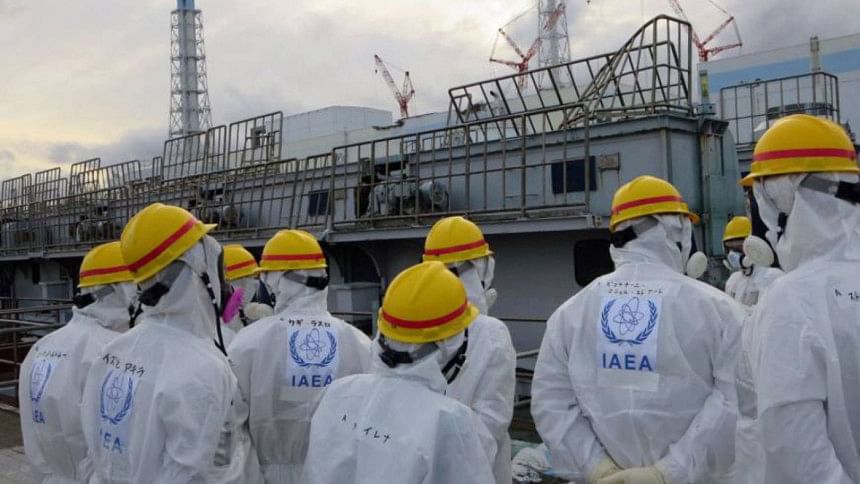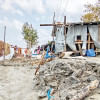Rising sea levels, rising threats

Almost all states now agree on the emerging threats to security from climate change, especially risks from sea-level rise to global peace and security. Bangladesh is no exception. In fact, Bangladesh is one of the most vulnerable countries from the threats of sea-level rise.
Sea-level rise (SLR) is a climate-induced and human-driven phenomenon. Growing population, increasing demand for natural resources, and rapid urbanisation are the major factors pushing sea-level rise to a risky extreme. Thermal expansion of water due to global warming remains one of the two main causes of SLR while the other is massive melting of ice sheets and glaciers. Scientists predict that even though the sea-level is estimated to rise 11 inches to 38 inches by 2100, a major breakup of the Greenland and West Antarctic ice sheets can easily raise it up to 23 feet, creating a doomsday scenario.
Low-lying regions around the world will suffer the most. For example, Bangladesh will lose a significant part of its territory to the rising sea, causing mass displacement of people. In the extreme case, island states like the Maldives and Papua New Guinea will disappear. Among all the regions, East Asia, Middle East, and North Africa bear the greatest relative impacts. Coastal areas will be severely affected. The most alarming news is that eight of the 10 megacities and many financial centres (i.e. New York, London, and Mumbai) in the world are situated in coastal areas which may be partially or completely lost due to SLR. This could cause global trade and the international financial system to face significant shocks. Supply chain management will also be adversely affected due to rising water levels in port cities like Rotterdam and Shanghai.
Many small island developing states will face an existential threat due to the rise in sea-levels. Loss of wetlands will result in massive territorial shrinkage. Even before being submerged, the viability of these states will already be threatened, as often sea-level rise makes islands uninhabitable long in advance. Disputes over maritime boundary are very likely to take place as baselines and shorelines will move from its present longitudes and latitudes. With even the slightest change in lines, the current regime of maritime boundaries based on the United Nations Convention on the Law of the Sea (UNCLOS) will be obliterated. Confusion over coastlines and borderlines will also create disagreement over EEZs and territorial seas and access to ocean resources. These might threaten inter-state relations and make peace more difficult.
Expansion of sea areas in habitat areas will displace hundreds of millions of people around the globe. Since 40-45 percent of the global population lives by the coast, the human loss and displacement is going to be enormous. Intra and inter-state migration will occur on a massive scale, which will eventually create an unhealthy distribution of populations. Lack of resources can further cause tension between host communities and migrants, which in extreme cases can even lead to the collapse of states. Regions already facing socio-economic tensions are likely to suffer more due to migration. Along with the loss of habitat, livelihoods will suffer too. Production of different sorts of crops will be halted and their quality can deteriorate due to salinised water. Hundreds of species of fish will be lost due to higher ocean temperatures, altered depth of water and associated changes in the chemistry of water. Similarly, many aquatic animal species will also be lost as the change in sea-level will affect their metabolism, functionality, ecosystem, growth rate, etc.
Food security will be hampered to a great extent as we lose agricultural land to rising sea-level. Quality of the remaining agricultural land will also worsen with saline water intrusion. Salt water contamination will make irrigation difficult. Expected production of crops will go down drastically. Rice production is predicted to be reduced significantly due to delta areas such as those of the Mekong and Red River being submerged. This food insecurity among people will gradually build up to an unstable security situation within and beyond states. Water security will similarly be threatened due to hyper-salinisation of water. Due to melting of ice, water will submerge coastal areas. Different sources of water will be contaminated by salt water. Sweet water will be contaminated by the infusion of salt water.
Energy infrastructures are highly vulnerable to sea-level rise. Nuclear reactors need uninterrupted water supply for cooling down the system which is why they are built near coastlines. Increased water levels will flood nuclear power plants which will affect the functionality of the reactors. The Fukushima power plant is a prime example, which in 2011's Tsunami was partly washed away in water and electricity supply was shut down, which prevented its regular functioning, causing radiation into the water and air. Destruction of coastal infrastructures will occur due to SLR. Port facilities, rail and road links, transmission facilities etc. will be heavily impacted. Capacity of coastal cities and states will decline severely as providing basic services to the population will become more difficult. Lack of services often aggravates the fragility of states.
Higher sea-levels have the potential to flood terrestrial habitat. Greater tidal intrusion will change the salinity regime of coastal freshwater. Due to increased depth of the sea, marine life will be exposed to various threats like lack of sunlight, wave energy, and oxygen, which will adversely impact the marine ecosystem and will become an existential threat. Alteration in chemistry of soil caused by saltwater will also impact the coastal plant life. Economic impact on the tourism sector due to SLR will be devastating. Caribbean nations alone will see 149 multi-million-dollar resorts lost to rising sea-level. Price of available high-end beach properties will skyrocket. Huge disparity over the supply and demand of property will resurface allowing only a small portion of the population access to shelter. All these effects could easily add up to civil unrest and conflict. Multidimensional insecurity of people can make them vulnerable and prone to crimes and violence. Price hikes in the Middle East caused by a draught in Russia had sparked riots in Tunisia, which eventually contributed to the events of the Arab Spring. Impacts of sea-level rise can therefore have long range, non-linear, multi-directional implications. Especially, lack of access to sweet water can give rise to new conflict scenarios. Conflicts among nuclear-armed states will make the situation worse as seen in the case of India and Pakistan over the Indus water treaty. Weak governance, a common feature among the climate change-vulnerable countries, will aggravate the internal anarchy.
Reversing completely the process of sea-level rise is not achievable. Some of the impacts of rising water level are inevitable. Hence, rather than focusing on reversing the process, the practical and attainable course of actions will be to mitigate it with the objective of preventing further aggravation.
Major General ANM Muniruzzaman ndc, psc (Retd) is the President of Bangladesh Institute of Peace and Security Studies (BIPSS).The article is based on an expert brief given earlier by the writer to the UN Security Council in New York.

 For all latest news, follow The Daily Star's Google News channel.
For all latest news, follow The Daily Star's Google News channel. 








Comments